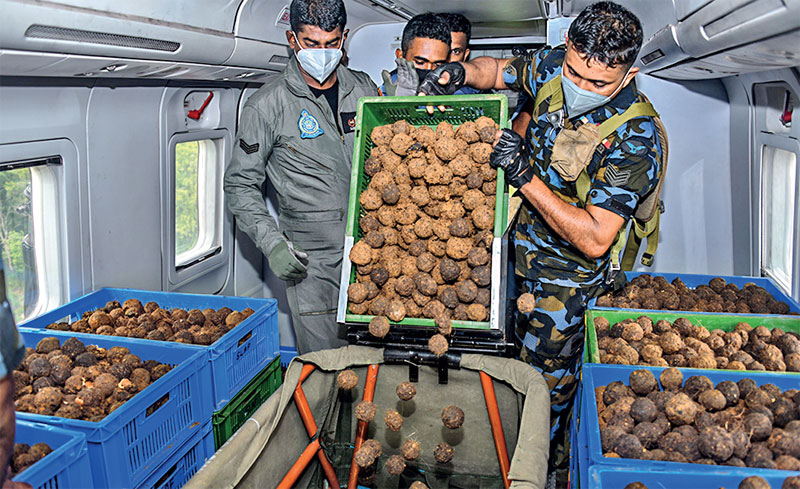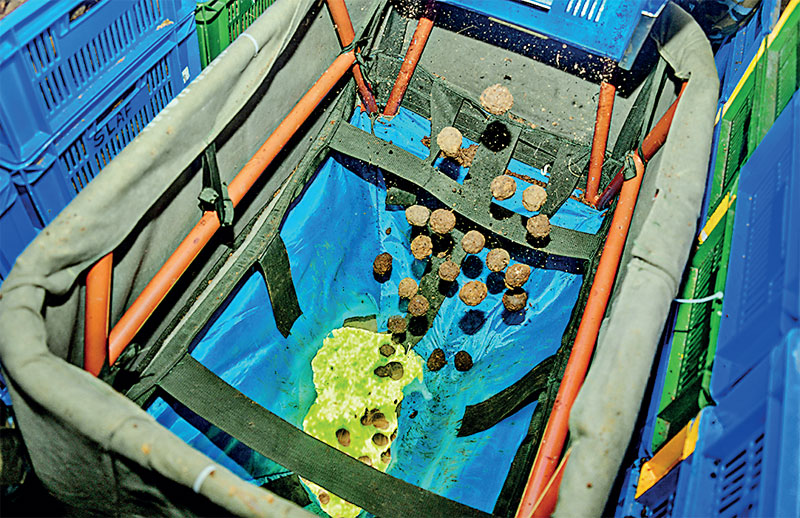Saturday Dec 13, 2025
Saturday Dec 13, 2025
Thursday, 25 November 2021 03:00 - - {{hitsCtrl.values.hits}}

The Sri Lanka Air Force under the guidance of the Commander of the Air Force Air Marshal Sudarshana Pathirana, together with the Forest Conservation Department, Faculty of Agriculture at the University of Peradeniya, Central Environment Authority and MAS Capital Ltd., instigated the sixth wave of seed bombing at Wattegama Kebilitta Government Forest Reserve in the Siyamblanduwa Divisional Secretariat on 23 November.
The Command Agro Unit at SLAF Base Katunayake, under the leadership of Group Captain Rajeev Kodippili and the Department of Forest Conservation, organised this mission to achieve the aim of improving the forest density of Sri Lanka in order to reach the sustainable development goals of the country by increasing the forest cover from 27% to 32% by 2030.
The first wave of the mission was executed at Ranorawa Government forest in a five-acre land area with approximately 5,000 seed bombs released. During the second wave 67,000 seed bombs were dropped over a 60-acre area inside the forest of Lahugala in Ampara. The third wave which was conducted in December 2020 saw the dropping of approximately 30,000 seed bombs over a 25-acre land area within the Lahugala National Park. The fourth wave was also carried out in the Lahugala National Park where 70,000 seed bombs were dropped over a 60-acre area. The fifth wave was carried out in the Kebilitta Government Forest Reserve where 80,000 seed bombs were dropped over a 75-acre area.
The seed bombs comprised native trees such as Kon (Schleichera oleosa), Kohomba (Azadirachta indica), Maila (Bauhinia racemose), Ma Dan (Syzygium cumini), Siyambala (Tamarindus indica), Mee (Madhuca longifolia), Palu (Manilkara hexandra), Kumbuk (Terminalia arjuna), Weera (Drypetes sepiaria), Bulu (Terminalia belerica), Kithul (Caryota urens), Munamal (Mimusops elengi), Aralu (Oroxylum indicum), Domba (Calophyllum inophyllum) and Ketakala (Bridilia retusa).
The total land area covered by this mission was approximately 70 acres with 65,000 seed bombs being dropped, and this mission was planned to coincide with the monsoon rain season as well in order to maximise its effectiveness.
SLAF Station Weerawila was utilised as the staging base for this mission as it was 29.3 nautical miles from the selected area. The MI-17 helicopter which was utilised for this mission was captained by Wing Commander Senaka Kooragamuwa while the co-pilot was Flight Lieutenant Sudara Amaradewa.



